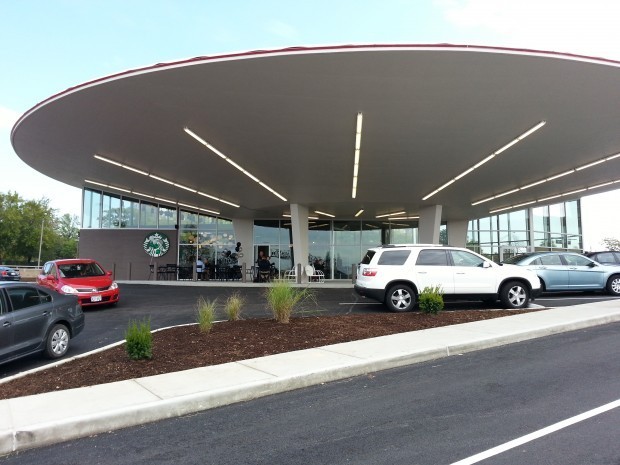A couple weeks ago the National Trust for Historic Preservation included an odd example of adaptive reuse in its Preservation Round-Up: a former gas station from the '60s, shaped like a flying saucer, is now home to a Starbucks. The building had also previously been the home of a Del Taco restaurant, but after it closed, had been "subject to an intense demolition threat." Among the preservation advocates who worked to save it from the wrecking ball was the original (now retired) project architect. While we're used to preservation stories about old schoolhouses and historic theaters, I think it's interesting to see an example where the building is so young the actual architect is still around to fight for it.
Wallace talked about historic preservation issues extensively, including adaptive reuse, the concept that "historic buildings should not be mummified, but recycled." While taking it to the extreme of "facadism" seems meaningless, I think adaptive reuse can be pretty nifty idea. It's not practical that every historic building be turned into a museum. Sometimes the building can be saved while at the same time putting it to some other use.
In this case, I think it was pretty great that the community was so vocal about saving the saucer. Some people might dismiss the modern architecture as ugly and not care to see it go, but how awesome is it to count a flying saucer among your town's landmarks? ("Yes, take a right on Main and then a left at the UFO.") This topic is also pertinent to our discussion of technology in public history: a Facebook page called "Save St. Louis Del Taco" garnered over 12,000 likes.
Read the full article here.
Wallace talked about historic preservation issues extensively, including adaptive reuse, the concept that "historic buildings should not be mummified, but recycled." While taking it to the extreme of "facadism" seems meaningless, I think adaptive reuse can be pretty nifty idea. It's not practical that every historic building be turned into a museum. Sometimes the building can be saved while at the same time putting it to some other use.
In this case, I think it was pretty great that the community was so vocal about saving the saucer. Some people might dismiss the modern architecture as ugly and not care to see it go, but how awesome is it to count a flying saucer among your town's landmarks? ("Yes, take a right on Main and then a left at the UFO.") This topic is also pertinent to our discussion of technology in public history: a Facebook page called "Save St. Louis Del Taco" garnered over 12,000 likes.
Read the full article here.

No comments:
Post a Comment